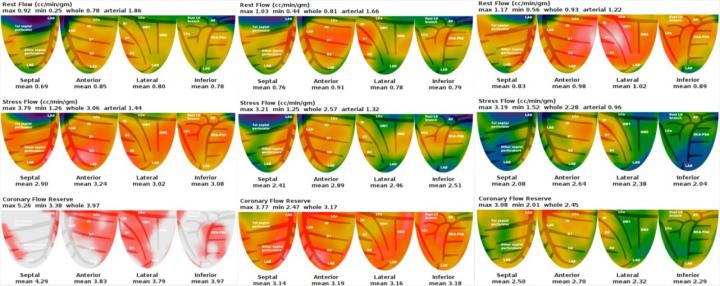
IMAGE: Left grouping: Mild OSA in a 38-year-old male, untreated. Center: Moderate OSA in a 49-year-old male, untreated. Right: Severe OSA in a 63-year-old male, untreated…. view more
Credit: Wang R, Wu P, Li L, et al.
Research presented at the Society of Nuclear Medicine and Molecular Imaging’s 2019 Annual Meeting draws a strong link between severe obstructive sleep apnea (OSA) and impaired coronary flow reserve, which is an early sign of the heart disease atherosclerosis. Using 13N-ammonia positron emission tomography/computed tomography (PET/CT), researchers were able to noninvasively evaluate coronary microvascular function in OSA patients and use their findings to predict cardiovascular disease risk.
Obstructive sleep apnea occurs when a person’s airway is blocked while sleeping, which causes intermittent pauses in breathing. According to the American Sleep Apnea Association, an estimated 22 million Americans suffer from sleep apnea, which is increasingly recognized as a cardiovascular disease risk factor. Left untreated, OSA can lead to high blood pressure, stroke, chronic heart failure and other cardiovascular problems.
To evaluate the cardiovascular disease risk factors in OSA patients, researchers conducted 13N-ammonia PET/CT imaging on 38 patients, who were divided into three groups based on the severity of their sleep apnea. During the PET/CT imaging, myocardial blood flow and coronary flow reserve–key indicators of coronary dysfunction–were automatically calculated using quantitative PET/CT software.
The mean rest myocardial blood flow was similar among patients in the three groups of mild, moderate and severe OSA. The mean hyperemic myocardial blood flow was also similar, though researchers found that the blood flow decreased gradually as the severity of OSA increased. There were, however, significant differences in the mean coronary flow reserve among the three groups–those with severe OSA had a substantially lower coronary flow reserve.
“As we all know, impaired coronary flow reserve is an early sign of atherosclerosis,” said Ruonan Wang, MD, The First Hospital of Shanxi Medical University in Taiyuan, China. “Our study suggests that patients with OSA, especially severe OSA, should receive PET myocardial perfusion imaging as early as possible to exclude coronary microcirculatory dysfunction.”
###
Abstract 163. “Evaluation of Myocardial Blood Flow and Coronary Flow Reserve with 13N-Ammonia PET/CT in Patients with Different Degrees of Obstructive Sleep Apnea,” Ruonan Wang (presenting author), Ping Wu, Li Li and Xianhai Xu, Department of Nuclear Medicine, The First Hospital of Shanxi Medical University, Taiyuan, China; Yuetao Wang, The Third Affiliated Hospital of Soochow University, ChangZhou, China; and Sijin Li (senior author), Department of Nuclear Medicine, The First Hospital of Shanxi Medical University, Taiyuan, China, and Molecular Imaging Precision Medicine Collaborative Innovation Center of Shanxi Province, Shanxi Medical University, Taiyuan, China. SNMMI’s 66th Annual Meeting, June 22-25, 2019, Anaheim, CA.
To schedule an interview with the researchers, please contact David Harrison at (410) 804-1728 or david@harrisoncommunications.net. All 2019 SNMMI Annual Meeting abstracts can be found online at //jnm.
About the Society of Nuclear Medicine and Molecular Imaging
The Society of Nuclear Medicine and Molecular Imaging (SNMMI) is an international scientific and medical organization dedicated to advancing nuclear medicine and molecular imaging, vital elements of precision medicine that allow diagnosis and treatment to be tailored to individual patients in order to achieve the best possible outcomes.
SNMMI’s more than 16,000 members set the standard for molecular imaging and nuclear medicine practice by creating guidelines, sharing information through journals and meetings and leading advocacy on key issues that affect molecular imaging and therapy research and practice. For more information, visit //www.
Disclaimer: AAAS and EurekAlert! are not responsible for the accuracy of news releases posted to EurekAlert! by contributing institutions or for the use of any information through the EurekAlert system.

